To celebrate international Women’s Day, this entire edition is devoted to the women who are breaking new ground, refusing to be confined to the stereotypical roles
Playing with fire
SHUBHAM BHATIA
When Taniya Sanyal from Kolkata was doing her Master’s in botany, she had no idea that one day she would become the first woman firefighter in the aviation sector. And instead of observing plants in a lab, she will be dealing with fire.
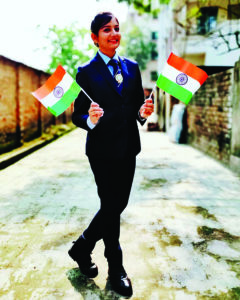
As she was preparing for the civil services exam, the urge to do something “out of the box” kept rising. She desired something “new, fresh and challenging.”
She saw an opening for a firefighter’s position at AAI (Airports Authority of India). Intrigued by the thought of changing her career, Sanyal applied for the position.
“The first step in their recruitment process was to crack a written exam, followed by a medical test, physical endurance test and driving test,” explains Sanyal.
The written test, she says, consisted of multiple-choice questions to test the candidate’s general knowledge, science and mathematics.. Sanyal cracked it and was called for the physical endurance test, which was held in Bhubaneshwar.
With her parents’ approval, she went for the medical test, “to check whether one is fit for the job.” She cleared this too and then attempted the driving test. “I drove a Bolero,” she adds.
She recalls that the physical endurance test demanded the candidates to complete a 100m stretch in just 20 seconds. Completing this, she was asked to “climb a rope, a pole and a ladder.” The challenge didn’t end there, all the candidates were told to carry 40 kg of weight on their body and walk for 60m. She emerged victorious in this too.
Not only did she clear all the tests, the support from her parents further boosted her confidence to take up the job. “They always say do what you desire. When I told them that I’ve cracked the exam, they were very happy. I am lucky that way,” says Sanyal.
In July 2018, she joined the AAI as the first female firefighter, standing out amongst the other 3,310 firefighters. On her interest in firefighting, Sanyal says “There was no fixed interest as such, but I used to follow the fire incidents in news.”
Currently, she’s posted as a demonstrator/trainer at Fire Service Training Centre (FSTC), Kolkata, which comes under Ministry of Civil Aviation. Earlier, she was getting training at FSTC’s centre in Delhi.
Though no fire incident demanded her services till now, she says, that the department continues to conduct mock drills to “keep us going.”
She spends her day training new recruits at FSTC, Kolkata and she says there’s a difference between a city firefighter and one who works in the aviation sector.
“We have a very short time. If a fire breaks out, we will get only 2 minutes and 18 seconds to complete all the steps,” shares Sanyal. Moreover, they will have only 10 seconds to reach the site.
And it’s not just about air crashes, but dealing with accidents occurring in terminal premises and the airport’s perimeter. Many a times, people are taken aback by her choice of career because of the risk involved. But she also admits that they all her happy for her now and support her.
Sanyal says “There are other ranks which I want to accomplish. Currently, I hold the non-executive rank, and in future I want to reach up to the executive or managerial rank.”
Flying high
PROMA CHAKRABORTY
Like most school children, Harleen Kaur Dang’s summer vacation was spent travelling down to her maternal family home in Mumbai. Born in Ahmedabad, she along with her family mostly took the train, yet for Harleen the few times they took a flight, was undoubtedly the most enjoyable.
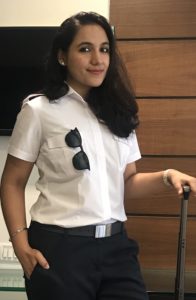
Seated as a passenger, she thoroughly loved the atmosphere in the flight – from the polite greetings of the airhostess to the small knickknacks like ear plugs and refreshments. Admiring them, she thought she wanted to be an airhostess when she grew up, until her father pointed out that the one responsible for taking them from one place to another is actually in the cockpit.
And suddenly, her entire focus was to be right there in the cockpit. Now, almost two decades later, she is exactly where she wanted to be. A senior first officer (the second pilot of an aircraft) with a leading airline, Dang (30) has been flying for almost five years now.
“Right in the early stages of my life I had decided I wanted to be a pilot. But then again, it was one of the many professions I wished to take up. I was very easy to influence as a child. I wanted to be a teacher and even a lawyer at one point of time,” she recalls with a laugh.
Right after finishing her boards, Dang wanted to start her pilot training – but being a very expensive course, her parents were naturally sceptical about it. “They pointed out that it’s not something you can fall back upon if you don’t get a job and they suggested that I take up something else as a back-up,” Dang adds.
Looking out for other options, she joined in the bandwagon of her friends and decided to pursue engineering. In the entire duration of the course she came across several notices of airlines hiring and often thought about quitting. Yet she completed her graduation and finally went ahead with her pilot training course in 2009.
Flying since January 2014, being a woman pilot she has received her fair share of reactions from passengers — most of which were appreciation. Going outside to greet the passengers after landing, she often meets women especially from the older generation who feel proud and happy to see a woman flying. “Were you flying? Were you doing the take-off and landing?” the passengers are often taken in by a pleasant surprise.
“Youngsters often want to take a look at the cockpit. Stepping in, they are awed when they look at the captain and when the captain points to me and says I did the landing and take-off, they are sometimes taken aback. So, there is still a slight element of surprise, when they see a lady as a command of a commercial jetliner,” Dang adds.
So, what does she love the most about flying? “It’s definitely the view,” she says quite excitedly. “As a passenger, you are restricted to a very less view but in front the sight is spectacular. Sunrise and sunsets are always magnificent.”
Dang loves the night flights towards the Middle East over the sea where one can spot shooting stars and constellations clearly. Flying towards the Northeast India, the confluence of the rivers is another breath-taking sight. “Whenever I get to see such a view, I always thank my stars.”
However, it has definitely become easier now compared to her time, to take this up as profession she explains. “With the amount of data and content available online, it makes research quite easy. If there are some questions in your mind, the answers are already available out there.”
Dang is looking forward to becoming a captain and her preparations are already on.
Ruling the roads
Shaunak Ghosh
In 2009, then 23-year old Sonia Jain, embarked on her first ever motorcycle ride outside Delhi to Rohtang Pass on an old Yamaha Rx100 – a bike which she describes as unsuitable for long journeys and was giving her a lot of problems. “Just 4-5 km before I reached the spot, the road was blocked by a huge landslide. It was quite late at night, but I refused to turn around and go away. I somehow managed to push the bike on the other side of the landslide — which was around 150 m- and I somehow managed to reach the spot,” says Jain.
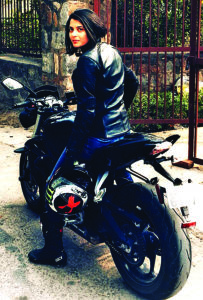
“The road teaches you a lot, and I learnt the level of my perseverance on that journey”, she adds. Ten years later, the now 32-year-old Sonia Jain is one of the most accomplished motorcyclists of India. In fact, she left her lucrative career as a marketing executive behind her as she decided to pursue professional motorcycling full-time.
“Motorcycling for me is a means of getting from one place to another without anyone’s interference, without depending on anyone,” says Jain. “Ever since I was a kid, I depended on my parents and family while travelling from one place to another. In my adolescence I had to take permission from my parents to go somewhere. So, biking for me is my way of expressing freedom- I take my bike anytime and travel wherever I can without anything to worry about,” she adds.
Jain has travelled across almost every state in India on her bike from Uttar Pradesh and Rajasthan to Tamil Nadu. In fact, she undertook a 3,000-km ride in 2016, travelling from Shimla to Ooty through numerous cities — Delhi, Jaipur, Ahmedabad, Mumbai, to name a few. According to her, her most special ride was her 25-day journey from Delhi to Bangkok via Myanmar – thus covering three countries by road via the Tri-Culture highway. “Through this ride, I aimed to capture the cultural diversity of these countries, and an attempt to bring the cultures together- hence the name of the trip being Urban Brotherhood Ride,” says Jain who claims to have spent 6-8 months planning this project.
But in spite of all these hectic rides, Jain says that a two-day trip to anywhere in the Himalayas has always been her favourite. “Whenever I get time, I embark on my journey to the hills — it feels so refreshing,” she adds.
She says that on the road she never faces any gender discrimination, rather “people are pleasantly surprised and then literally happy every time I take off my helmet”.
Jain has also entered the Limca Book of Records as the first woman to ride 100 different motorcycles, her favourite ride being the Triumph Tiger.
She not only enjoys taking trips on her bikes, but she also likes to talk to young women and inspire them. In fact, on her next journey — a full-state ride of Madhya Pradesh — she is also going to various schools and colleges to educate young minds about women’s empowerment. “I want them to realise that any woman can choose any career path she wishes, even unconventional ones”.
Jain says that she takes inspiration from people she meets on her journeys. “I have met so many women in villages who work day in and day out, and I feel they are the women who define what empowerment is all about,” she says.
Jain’s main aim, however, is to make people more aware about motorcycling. “People in India think biking is rebellious — one who has no aim becomes a motorcyclist,” she says. “My biggest struggle is to make people realise that biking is something that gives you new experiences — you get to see and learn things you cannot through any textbook. I want to tell people that biking is something very, very positive and liberating,” she concludes.
Laughing it up
SREYA DEB
“PMS stands for ‘Premenstrual Syndrome’ or ‘Purchase More Shoes’ or…‘Patriarchy Misogyny and Sexism,” she deadpans.
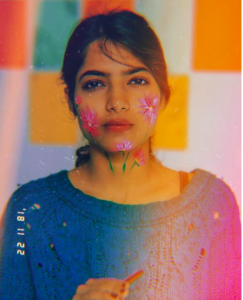
Stand-up comedy was the most unexpected thing to happen to Shreya Priyam Roy. Gearing up for her gig for International Women’s Day title Aaj ki Naari Sab pe Bhaari, she tells us about how, despite being a fairly open community of artists, sometimes a subconscious sexism is evident.
Roy actually started doing comedy on a suggestion from someone else, and now, she says, “It’s like I’m dating comedy. I can’t imagine my life without it!” Despite her enthusiasm and her obvious talent on stage, she is a self-declared introvert.
She makes sure to declare in all her social media handles that she is shy. How then, does she avoid stage fright? Well, she says that the fact that she is shy in real life helps her to create different characters and translate them onstage. “I am still working on it,” she admits, but makes sure to add that she may be shy, but she definitely does not shy away from telling her stories.
Roy believes that the comedy circuit is very inclusive in nature. But sometimes, the deep-rooted sexism does become apparent. She says this is true not only for the artists but for the audience as well.
According to her, “The Delhi comedy circuit is good and inclusive,” mentioning that a lot of comedians have helped her along the way. However, they do not make up for the instances of sexism she has seen amongst stand-up comedians. It gets particularly difficult during the shows when the audience happens to be male dominated: “I do feel sometimes that the audience is not as receptive to female comedians.” They tend to not take female standups seriously, because they are not used to women making jokes or observations on serious subjects.
As a female comedian, does she feel duty-bound to talk about subjects related to feminism? A lot of her content is about normalising the notion of periods. Roy says that she does consciously try to tailor her content to feminist subjects that she feels require attention.
When asked about whether she has a process or a rulebook for the content that she performs, she says no. “I really don’t know if there is a rulebook at all, I go simply by intuition.” She makes observations and takes suggestions, and then out of that, comes the content that she ends up performing. In spite of being shy, she doesn’t overthink her bits. “Sometimes it works, sometimes it doesn’t” but she tries to not censor her thought process when she performs.
Stand-up comedy has a reputation for being one of those professions where women don’t flourish as much as men. This generation of comedians, however, is not willing to settle for that. A whole flurry of women have come out of the woodwork to make their mark in stand-up comedy.
It’s been a short while since Roys’s first performance and the thing that will keeps her going is that she loves telling stories on stage. Drawing inspiration from the anvils of her experiences with every person and instance in her life, she carefully crafts her scripts for the stage — telling hilarious stories with a side serving of seriousness.
From real to reel
SHRUTI DAS
She is bold. She is brave. And she’s beautiful. All these adjectives also hold true for her documentaries. But Vibha Bakshi is much more than just a filmmaker.
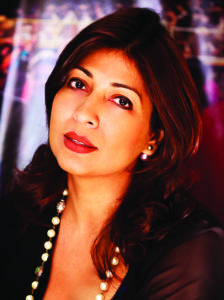
Bakshi started as her career a journalist, and then ventured into filmmaking. Her documentary, Daughters of Mother India – which is based on the events after the Delhi gangrape of 2012 — won the National Film Award for Best Film on Social Issue in 2015. Her films include Terror at Home – which was part of US government’s Emmy Award winning campaign to stop violence against women. And she also directed HBO’s Too Hot Not to Handle – which dealt with the issue of global warming.
“I am focused on making films based on social issues,” she says. Bakshi strongly believes that her films cannot address every challenge or issue, but can surely break silence. Her latest documentary – Son Rise – dealt with gender inequality and was also a part if UN’s HeForShe campaign. It was appreciated widely as soon as it released. “What I have tried in my small way is that whenever I do take up a social issue, I cannot change the world, but what I can do through my films is to start a conversation. To create a dialogue, where I leave it to people to bring a change,” she shares.
Through Son Rise, she also tried to spread an important message – that gender equality can only be achieved when both men and women are part of the struggle. “What we need is not to have men on one side, women on the other. To fight gender inequality, both men and women need to realise that this is a fight we cannot afford to lose. And if we are together in this – it’s a win-win situation. Thus, men should also become part of that struggle.”
She faced numerous challenges while filming these documentaries, but she believes every woman is unstoppable. “But while you have freedom, you also have a responsibility.” In Son Rise, she interviewed only men – that too in a patriarchal society like Haryana. “I knew I was going to enter the seat of patriarchy, but then I had to have the belief in myself that I can do it.”
Bakshi says that what she realised is, as a woman, there is a lot of proving to do in our society. “I may have the competence, the ability, the strength to bring about the change – but the only difference is I have to constantly prove it. Women have the greater challenge to constantly prove it. But that will not stop us,” she states with conviction.
When asked which powerful woman inspires her, she says within seconds: “I look up to my mother.” She further adds, “My mother, in her own ways, has broken a lot of glass ceilings. And she gives me the strength to constantly challenge the status quo.”
Her documentaries – which are based on strong social issues and are brutally honest – unfailingly portray the dark truths of society. “I believe all my films deal with the darkest of subjects, but in the end, they always leave you with hope.”
Bakshi firmly believes that gender inequality, which is an issue to be reckoned with, is not only women’s issue – but is a human rights issue. “When we talk about equality, it’s not men versus women. We, together, need to be part of that struggle. It is a human rights issue. When a woman is violated or raped, is it only a woman’s issue? Everyone has the right to feel safe. It is a basic right. We are all in this together,” she concludes.
Activism at heart
SASHIKALA VP
In a crowded Delhi market, Swati Maliwal is surrounded by people trying to come closer and listen to her speak about uniting women, making the city a safe place, fighting assault, and holding authorities accountable.
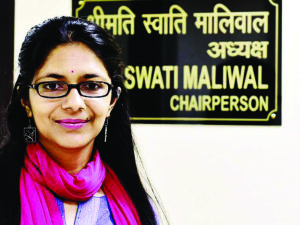
The Delhi Commission for Women (DCW) chief stands tall, even as she unflinchingly calls out the role of the police in the illegal rackets of the Capital. And that is what best describes her – a person who does not seem afraid to call a spade a spade.
An engineer by training, she gave up her job to become an activist. “I had got a joining letter from an MNC. And there was a three-month joining period. During that time, I was just walking in my area and I saw an old man teaching underprivileged children. And I felt guilty.”
This guilt made her start helping this man out. And within a month, “My whole world’s perspective changed. I realised the huge difference between the India I belong to and the Bharat these children belong to. So, I decided to take a year break and do activism.”
She told her parents; her plan was to go abroad and work after this gap year. “I don’t remember when this one year converted into 14-15 years. But I am the happiest woman alive, doing this job.”
“I don’t believe in armchair activism”, Malliwal says as she walks briskly to the next pit stop of her Mahila Suraksha Padyatra (February 28 to March 8) – to highlight issues plaguing women’s safety and to understand the situation on the ground.
One can see the impact of her impassioned words, especially with young girls who approach her as she sits down to take a sip of water. They stand next to her, trying to get a picture taken with a woman who has the power, passion, empathy and will to fight for the rights of people. But her youthfulness and her sex are exactly what has worked against her, Maliwal says.
While during her activism days she never felt discriminated against, after taking on the role in DCW she felt more than the pinch of patriarchy, “because now I am dealing with senior officers, the police”.
Once, she says “a very senior government officer” told a Delhi government minister “Woh jo tumhari kal ki chokri hai, usko samjha dena nahin toh usko theekh kar dunga” (Make that girl born yesterday understand else I’ll straighten her out”). Would a man have been spoken about in the same way?
In fact, when she had just taken the reins as DCW chief, the then Delhi police commissioner BS Bassi had refused to share status of crimes with her. “I wrote regularly to him for six months. I think he must have thrown my letters in the dustbin. After six months, I issued a notice to him demanding the data, which is my statutory right. He got so offended that he wrote back a lengthy letter saying that if I give you information there will be a law and order problem in the Capital.”
Undaunted, Malliwal summoned him and told him that if he did not give her the information, she would issue an arrest warrant against him. The data came and with it also came two FIRs. “What I am trying to say is that patriarchy is there, I have faced it both within and outside the system” but “You just hold your ground and do whatever is right.”
An audacious person, Maliwal does not get cowed down by criticism. In 2018, she went on a 10-day hunger strike demanding death penalty for child rapists. While the Centre agreed and passed a law, people were critical of the demand. Asked about this, she simply replied, “I care about the situation on the ground, which is that there aren’t any convictions.”
While she agreed that there were issues of human rights, what she wants to concentrate on are “the human rights of the survivors and the victims” and not the perpetrators. She believes that in another 30 or 50 years when the country becomes “better”, it can think about the human rights of perpetrators, but not under the present circumstances.
For now, she wants to focus on, amongst various measures, the creation of Mahila Suraksha Mitra – which will have volunteers looking out for the community’s welfare, because the “solution is in the unity of the people”.
Unity is something women lack, Maliwal says, because they are overburdened with responsibilities and have a complete lack of freedom: “Lack of freedom to express their own views, the lack of freedom to make decisions for their lives, the lack of freedom to be able to think as individuals and not just as a mother, sister, wife, and the lack of freedom to do what they want to do.”
She believes that with support from the people and authorities, we can have a Delhi free from the grip of drugs and alcohol. “One which is safe for women. Where there’s no prostitution. It’s achievable”.
“It’s not utopia that we are talking. We were silent when it was becoming this bad. If we don’t remain silent now at least we can stop it from becoming worse. And I think we can reverse the cycle”.
Quite a role model for young women today.





